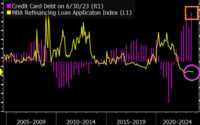Inflation Could Create a Sticky Situation
Sometimes sharply rising fuel prices don’t end up being inflationary. Unfortunately, this may not be one of those times.
The Commerce Department on Thursday reported that consumer prices rose 0.6% in February from January, putting them 6.4% above their year-earlier level. A fair portion of that gain came about as a result of the higher prices Americans were paying at the pump. With regular gasoline averaging $4.22 a gallon in the U.S. in March versus a February average of $3.52, according to the Energy Information Administration, the March inflation figure seems bound to come in even hotter.
Economists and policy makers tend not to focus so much on the overall inflation number, however, but on core prices, which exclude food and energy items. It is a practice that always comes in for a bit of criticism during times like today when prices for gasoline and, to a lesser extent, food, have risen so much—after all, it isn’t as if those more expensive trips to the gas station and supermarket don’t hurt people. But the point is that fuel and food costs can be really volatile, with big moves higher followed by big declines. Indeed, over the past three decades, spikes in fuel costs ended up not having much of an effect on inflation’s overall trend.
But even though core prices haven’t risen quite as much as overall prices have, Thursday’s report showed that they were up 5.4% last month from a year earlier—the most since April 1983. Such an acceleration coming in the context of a jump in fuel costs—last February they were up only 1.5% from a year earlier—is something that hasn’t occurred since 1980, when oil prices were moving sharply higher in the wake of Iran’s 1979 revolution. The time it happened before then was during the oil crisis that began with the 1973 Arab Oil Embargo. In both cases it appears that the rise in fuel prices had a meaningful effect on inflation’s trend, pushing the prices for other things higher.
One reason might be that the increases in fuel costs those crises brought about were long-lasting—oil prices were permanently higher following the oil embargo, and after jumping again following Iran’s revolution they remained elevated for years. So they had plenty of time to work into prices for other things. Manufacturers and retailers couldn’t eat higher production and transportation costs forever, for example. And workers, wanting to get compensated for the extra bite pump prices were taking out of their paychecks, demanded higher wages.
Whether the jump in oil prices following Russia’s invasion of Ukraine will be short-lived is, of course, unknowable. But that it is happening in the context of prices for other things rising is, in and of itself, worrisome. When gasoline prices surge and prices for other things don’t, people grumble, but they might not worry that higher inflation is a permanent state of affairs. When gasoline prices run up along with those of other things, they might start thinking inflation is going to stay high for a while.
That can end up becoming a self-fulfilling prophecy.
Write to Justin Lahart at [email protected]
Copyright ©2022 Dow Jones & Company, Inc. All Rights Reserved. 87990cbe856818d5eddac44c7b1cdeb8
[ad_2]
Source link

